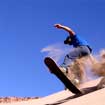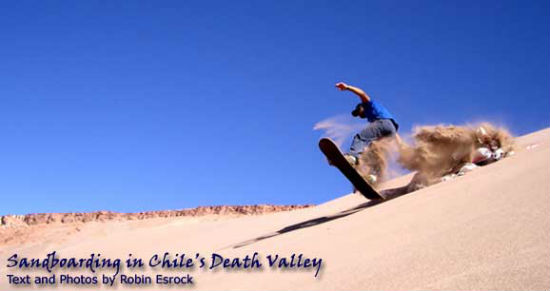

San Pedro in northern Chile’s Atacama Desert has evolved from a small village into a pit stop for buses of name-tagged tourists and salt-crusted travelers from Bolivia. Its dusty streets belie the fact that San Pedro has hotels that somehow manage to charge US$ 100 for rooms without room service, and bars and restaurants where a highball can set you back US$ 10.It’s not what you expect from a small town in one of the driest regions on the planet, two hours from the nearest bank machine. San Pedro, however, is the base to explore the majestic Valley of the Moon and the explosive desert geysers. The more adventurous can try one of the region’s popular sports — sliding down a dune with a plank of wood strapped to your feet.
I imagined sandboarding would be much like snowboarding, except hotter and without layers of Gore-Tex. Actually, I’m told it’s closer to surfing, but I wouldn’t know because I spent too much time falling like a chicken dropped out of an airplane. Mind you, that does sum up my surfing experience.
I had arranged my trip with Atacama Expeditions, whose Brazilian guide, David, was a professional sandboarder seeking sponsorship to compete in the United States. He didn’t speak much English, but his skin was deeply tanned, he could do cool back flips, and he managed to pick up some girls from another group on the dunes, thereby displaying all the attributes one looks for in a ski, snow or sandboard instructor.
The shuttle bus dropped us off in a part of the Atacama dramatically named Death Valley, primarily because nothing lives out there, but also because it sounds great for the tourists (the Valley of the Moon had been named as recently as the 1970s, after someone saw footage of the lunar landing and saw the similarities). The boards resembled shorter snowboards, with Velcro straps to secure your feet, and blunt rounded edges. Although the pros go barefoot, we were advised to wear low-cut shoes to avoid any injuries when falling, which apparently we’d be doing a lot of.
I quickly learned the first and most important lesson of sandboarding, that is, in order to come down, you have to walk up. It was still early in the morning, but my factor 30 sunblock was already out as we walked up towards a rocky ridge. Ten minutes later, the full beauty of Death Valley lay before us: the dunes rolling to the valley floor while the perfect cone of a volcano loomed in the distance. The biggest victims of Death Valley are apparently cameras, which fall prey to the super fine red dust that blows in the wind. Yet, it is hard not to try to capture the vast beauty and sheer desolation of the place.
We walked along the ridge, the sun heating up by the minute, until David decided where to hop off onto the dune. The ensuing lesson proceeded thus: wax your board with a broken candle, strap your feet in, stand up, lean back, and go forward. Leaning back is the biggest reason why sandboarding is compared to surfing as opposed to snowboarding, as is the constant waxing.
The board itself will not slide down the dune unless it is waxed, and when the wax is worn off from attrition with the sand, you can find yourself standing up on a steep slope, leaning back, and going nowhere. Boards need to be waxed repeatedly, especially if you fall a lot, which you will. David strapped himself in, stood up, pointed straight and flew down the dune. There was no carving, just a solid line down.
Confident by how easy he made it look, I stood up, leaned back, started picking up speed, and then promptly fell head first, mouth open, into the sand. A few weeks later, I would swear there was still sand between my teeth. I stood up and tried again, except this time my board wouldn’t go because it needed more wax. Straps off, wax on — I felt like the Karate Kid. Eventually I got to the bottom realizing that without the speed, there is no descent. And unlike snowboarding, you can’t use your edges to slow down, but together with a wipeout you can use them to stop dead.
Fortunately, we did not need to climb the 130 feet (40m) to the top of the dune, because it continued a few meters away to the bottom of the valley. Here, I managed to stay up a good few seconds, feeling the brief rush in my face before the inevitable tumble. At the bottom, David did the one thing I really hoped he wouldn’t. He started walking back up the dune.
Each step feels like five as sand rushes in your shoes, and it took about 15 exhausting minutes to reach the mid-way point. This time, we would attempt a man-made ramp constructed with sandbags. David went first, and after what looked like an explosion of dust, he quickly flew to the bottom of the valley. The last time I attempted a similar jump on snow I bruised a few ribs, so naturally I went for it on sand. Passing the camera to Phillipe from France, I approached the ramp at speed, got terrific air, and then proceeded to fill every orifice in my body with the fine desert dust that destroys cameras. Fortunately, I was rewarded with a terrific shot, and 15 minutes of hell back up the dune. This pattern was repeated for the next two hours, where I ate far more than the recommended daily allowance of sand.

David explained in broken English that Brazil has dunes where a single ride could last 45 seconds! I thought of the 45 minutes it takes to descend the gorgeous alpine ski slopes in Whistler (Canada), and also about the fast ski-chairs that take you back to the top when you’re done. With the amount of waxing, falling and uphill dune hiking sandboarding required, I had yet to fathom its appeal to the growing masses in Latin America. Then again, it did result in spectacular pictures, not to mention tourist dollars from gringos in search of a unique adventure in the desert.
If You Go
Sandboarding in San Pedro de Atacama costs between US$ 25 – US$ 30 with instructors, although you can rent boards for about US$ 10 a day and try it alone. Tours last about three hours. Take lots of water.
Atacama Expeditions
www.atacamaexpeditions.cl
Sandboard Magazine
Chilean Tourism Promotion Corporation
www.visit-chile.org
- Life of a Champion: Exploring the Muhammad Ali Center in Louisville - April 19, 2024
- What It’s Like to Live as an Expat: Lake Chapala, Mexico - April 18, 2024
- Top 5 Spots for Stargazing in North Carolina - April 17, 2024
